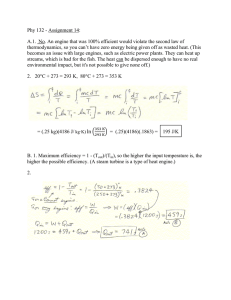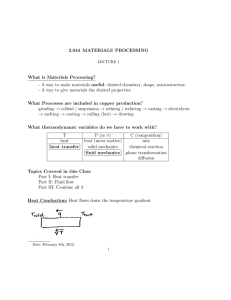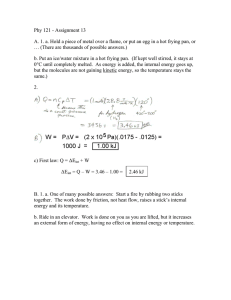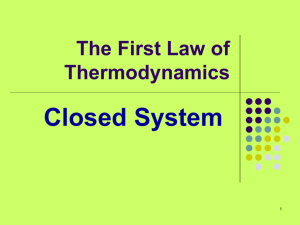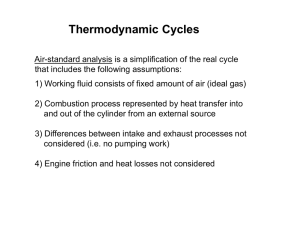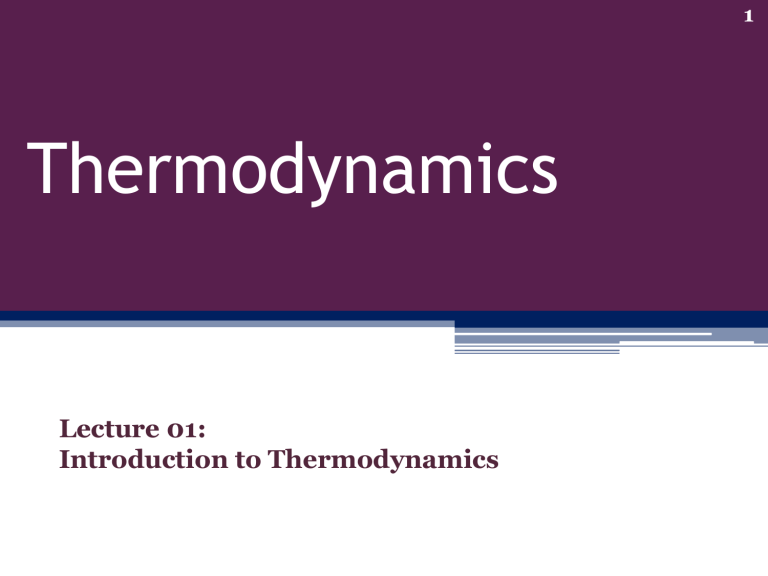
1 Thermodynamics Lecture 01: Introduction to Thermodynamics Thermodynamics Definition -- Thermodynamics is the science of energy and entropy -- Thermodynamics: the branch of physics dealing with the relationships between heat, work, and forms of energy. From the Greek: - θερμη, therme, meaning “heat“ → Energy - δυναμις, dynamis, meaning “power“→ Transport To the Engineer…Thermodynamics means: - Understanding the 4 Laws of Thermodynamics - Learn to work in with four different temperature scales. - Learn to balance energy, heat, and work with respect to open and closed systems. - Learn about common thermodynamcis devices and applications and how the principles can be used to predict system performance and efficiencies. Thermo….a Quick Survey -- Properties of systems: Temperature, Pressure, Specific Volume, Phase, Quality, Density, Enthalpy, Entropy -- Processes and Cycles: State to state transitions. Carnot cycle, Rankine cycle, Otto cycle, Diesel cycle, Brayton cycle, Refrigeration cycle -- Work-Energy-Heat Balance: Applying the 1st Law of thermodynamics Thermo…A Quick Survey…continued -- Entropy Production and Accounting: Applying the 2nd Law of thermodynamics -- Thermodynamics devices: Turbines, Heat Exchangers, Condensers, Engines Pumps, Cooling Towers, Compressors, Diffusers -- Psychrometrics: HVAC, heating, ventilation, air conditioning, and humidity -- Combustion and Power Production: Chemical energy production and balances A basic concept: System • A System is whatever it is that we want to study. • In thermodynamics, the first step in defining any problem is to define exactly what is to be monitored, examined, measured, etc. Environment Interactions System Boundary System Definition Radiation Radiation System Definition Radiation Radiation System Definition Gas Q System Definition Gas Gas Q W Types of Systems • Isolated Systems – matter and energy may not cross the boundary. • Adiabatic Systems – heat may not cross the boundary. • Diathermic Systems - heat may cross boundary. • Closed Systems – matter may not cross the boundary. • Open Systems – heat, work, and matter may cross the boundary (more often called a Control Volume (CV)). Types of Systems • Isolated Systems – matter and energy may not cross the boundary. • Adiabatic Systems – heat must not cross the boundary. • Diathermic Systems - heat may cross boundary. • Closed Systems – matter may not cross the boundary. • Open Systems – heat, work, and matter may cross the boundary (more often called a Control Volume (CV)). Closed System • Matter (m) may not cross the boundary. • Heat (Q) and Work (W) may cross the boundary which change the energy (ΔE) of the system. Po, Vo, To Combustion CxHy+A O2 B CO2 + C H2O Pf, Vf, Tf Q ∆V →W Control Volume / Open System • Heat (Q), work (W), and matter (m) may cross the boundary Ga s Q System Properties • The State of a system is defined by its properties (T, V, P, E, ρ, v, u, h, s) • Extensive properties – Depends on mass • Intensive properties – Does not depend on mass. • Give some examples of Extensive Properties Intensive properties Process vs. Cycle. • A Process is when properties of the system undergo a change. A process moves from one “state” to another “state”. • If State i = State f then system is said to be Steady State. • If a Process undergo changes that eventually bring it back to the original state, these transitions together are called a Cycle. Process: Cycle: P P S1 S2 S2 S1 S4 S3 v v Unit Review: Weight and Mass Weight Mass U.S. Customary pound , lbf pound of mass, lbm or slug Metric Newton, N kilogram, kg W =m g where g = 9.81 m/s2 g = 32.2 ft/s2 1 N = 0.2248 lbf 1 lbf = 4.4482 N 1 kg = 2.205 lbm 1 lbm = 0.4536 kg 1 slug = 32.2 lbm = 71.0 kg Relationships: Conversions: Unit review: Density and Specific Volume Density ρ mass basis U.S. Customary [lbm / ft3 ] molar basis mass basis Specific Volume v or v [ ft3 /lbm] [ ft3 /mol] [kg/m3] [ m3/kg] Metric molar basis [m3/mol] Relationships m = mass V = Volume m V M = molecular weight n = number of moles n m M 1 M Unit review: Pressure Pressure = U.S. Customary Presure head [psi ] or [lbf /in2 ] [psf] or [lbf /ft2 ] [in of Hg ] [ in of H20 ] [ft of H20] Metric [N/m2] [ Pa] [bar] [mm of Hg ] [ mm of H20 ] [cm of H20] Other atm Relationships: 1 atm = 14.69 psi = 1.01325 bar = 100 324 Pa = 760 mm of Hg = 29.92 in of Hg = 33.96 ft of H2O Gage vs. Absolute pressure pabs = patm + pgage Vacuum vs. absolute pressure pabs = patm - pvac Unit review: Temperature Metric U.S. Relative Temperature Celcius [ oC ] Fahrenheit [ o F] Absolute Temperature Kelvin [K] Rankine [ oR ] Relationships K = oC + 273.15 oR = oF + 459.67 oC =( oF - 32)/1.8 oF= 1.8 oC + 32 oR = 1.8 K Example 1: An object whose mass is 35 lb is subjected to an applied upward force of 15 lbf. The only other force acting on the object is the force of gravity. Determine the net acceleration of the object in ft/s2 assuming the acceleration of gravity is constant (g = 32.2 ft/s2). Is the net acceleration up or down? FAF= 15 lbf mass= 35 lbm Fg= 15 lbf Example 2: A system consists of N2 in a piston-cylinder assembly, initially at P1 = 20 psi, and occupying a volume of 2.5 ft3. The N2 is compressed to P2 = 100 psi and a final volume of 1.5 ft3. During the process, the relationship between P and V is linear. Determine the P in psi at an intermediate state where the volume is 2.1 ft3 and sketch the process on a graph of P vs V. P1= 20 psi V1 =2.5 ft3 P2= 100 psi V2 =1.5 ft3 Example 3: A monometer is attached to a tank of gas in which the pressure is 104.0 kPa. The manometer liquid is mercury, with a density of 13.59 g/cm3. If g = 9.81 m/s2 and the atmospheric pressure is 101.33 kPa, calculate (a) The difference in mercury levels in the manometer, in cm. (b) The gage pressure of the gas in kPa and bar (c) The absolute pressure of the gas kPa, atm, and psi Chapter 2 Lecture 02: Work and Energy Sec 2.1: Reviewing Mechanical Concepts of Energy Work, Heat, and Energy Energy is conserved, but can be converted to different types Ways to Transfer Energy Into or Out of A System Work – transfers by applying a force and causing a displacement of the point of application of the force. Mechanical Waves – allow a disturbance to propagate through a medium. Heat – is driven by a temperature difference between two regions in space. Matter Transfer – matter physically crosses the boundary of the system, carrying energy with it. Electrical Transmission – transfer is by electric current. Electromagnetic Radiation – energy is transferred by electromagnetic waves W = PE = KE = U 26 Sec 2.2: Broadening Our Understanding of Work Thermodynamics “Work” Physics definition of work is W = F s But, in thermodynamics often we are working with fluids (non-solids), so we need a broader definition. “Work is done by a system on its surroundings if the sole effect on everything external to the system could have been done by raising (or dropping) a weight.” 27 Sec 2.2: Broadening Our Understanding of Work Joule’s Experiment (1845-Salford, England) Joule dropped a known mass and measured the change in temperature of the water. The experiment was conducted in the basement of his family’s brewery, where there was a constant ambient temperature. The friction of the water molecules rubbing together caused the temperature to increase. Joule’s Equipment - Manchester 28 Sec 2.2.1: Sign Convention 29 Work Sign Convention W > 0 : Work done BY the system W < 0 : Work done ON the system Sign is not inherently important, but this is the convention. Vf W Vi W < 0 : Work done ON the system (System is compressed) PdV W > 0 : Work done BY the system (System expands) Sec 2.2 .2: Power Power = Rate of Energy Transfer Book’s convention: Dot above symbol represents the rate. The rate of work can be expressed as 30 Sec 2.2 : Work 31 Work Properties Work is NOT a property of a system like V, T, or E. Work occurs when the system undergoes a process. A differential of a property is exact. V Vf Vi dV V f Vi The differential of work depends upon the path. W Vf V Vi pdV Sec 2.2 : Work 32 But, work depends on the process. For “Bobby” work depends on the path, since friction is a nonconservative force. Sec 2.2 : Work So, we need to have a PV relationship for the process. The process of changing volume is NOT necessarily in equilibrium. - He balloon popping, gas does not instantly mix with air - Gas cylinder rupture, pressure inside is higher then outside for some time, t For this class, we will used an idealized process, that are completely reversible. We call this type of process - quasi-equilbirium - quasi-static 33 Sec 2.2 : Work 34 V V V Non-quasi-static Process Consider a box initially divided in half. - Initially, one is filled with gas, the other a vacuum. - The divider is then removed. - The gas takes some time to fill the new volume. During that time, there are different local values for P in the volume. There is also likely some heat generated, as the process is irreversible. Thermodynamics ≠ Kinetics Sec 2.2 : Work 35 V V V V V V V V Quasi-static Now we move the wall slowly, such that the gas is able to adjust instantly. This is a reversible quasi-static process. 36 V Example (2.34): Air contained within a piston-cylinder assembly undergoes three processes in series. Evaluate W. Process 1-2: Compression at constant pressure from p1=10 psi, V1=4.0 ft3 to state 2 Process 2-3: Constant volume heating to state 3, where p3=50 psi Process 3-1: Expansion to the initial state, during which the p-V relationship is pV = constant. 50 P psi 10 V ft 3 4 37 Sec 2.3: Broadening Our Understanding of Energy 38 Energy Physics energy types Kinetic Energy: Energy of objects in motion Potential Energy: Energy of objects in a field (g,E,B) Internal Energy Spring Chemical Pressure Pressure can be a form of energy if P> Patm Thus, the general energy equation is E PE KE U P Patm 39 Example Problem (2.37) A 10 V battery supplies a constant current of 0.5 amp to a resistance for 30 min. a) Determine the resistance, in ohms. b) For the battery, determine the amount of energy transfer to work, in kJ. Solution: 40 Example Problem (2.31) Air contained within a piston-cylinder assembly is slowly heated. As shown in Fig P2.31, during the process the pressure first varies linearly with volume and then remains constant. Determine the total work in kJ. P (kPa) Solution: 2 150 100 3 1 50 0.030 0.045 0.070 V (m3) Chapter 2: Lecture 03: 1st Law of Thermodynamics and Introduction to Heat Transfer Sec 2.4: Energy Transfer by Heat Heat, Q: An interaction which causes a change in energy due to differences in Temperature. Heat Flow Rate, Q: the rate at which heat flows into or out of a system, dQ/dt. Heat flux, q: the heat flow rate per unit surface area. Q Q dt 42 Sec 2.4.2: Heat Transfer Modes 43 3 Types of Heat Transfer Conduction Radiation Convection Conduction: Heat transfer through a stationary media due to collision of atomic particles passing momentum from molecule to molecule. Fourier’s Law dT Q A dx where κ is the thermal conductivity of the material. Sec 2.4.2: Heat Transfer Modes 44 Types of Heat Transfer Convection: Heat transfer due to movement of matter (fluids). Molecules carry away kinetic energy with them as a fluid mixes. Newton’s Law of Cooling: Q hc A Tb T f hc = coefficient of convection (An empirical value, that depends on the material, the velocity, etc.) Sec 2.4.2: Heat Transfer Modes 45 Types of Heat Transfer Radiation : Heat transfer which occurs as matter exchanges Electromagnetic radiation with other matter. Stefan-Boltzmann Law: Q ATb4 Tb = absolute surface temperature ε = emissivity of the surface σ = Stefan-Boltzmann constant Sec 2.4.2: Heat Transfer Modes 46 Summary of Heat Transfer Methods Conduction: where A is area κ is thermal conductivity dT/dx is temperature gradient dT Q A dx Convection: Q hc A Tb T f Radiation: Q AT 4 b where A is area hc is the convection coefficient Tb -Tf is the difference between the body and the fluid temp. where Tb is absolute surface temperature ε is emissivity of the surface σ is Stefan-Boltzmann constant A is surface area 47 Example (2.45): An oven wall consists of a 0.25” layer of steel (S=8.7 BTU/(hftoR) )and a layer of brick (B=0.42 BTU/(hftoR) ). At steady state, a temperature decrease of 1.2oF occurs through the steel layer. Inside the oven, the surface temperature of the steel is 540oF. If the temperature of the outer wall of the brick must not exceed 105 oF, determine the minimum thickness of brick needed. 48 49 Example Problem (2.50) At steady state, a spherical interplanetary electronics laden probe having a diameter of 0.5 m transfers energy by radiation from its outer surface at a rate of 150 W. If the probe does not receive radiation from the sun or deep space, what is the surface temperature in K? Let ε=0.8. Sec 2.4: Energy Transfer by Heat 50 Recall from yesterday: by convention Work, W: W > 0 : Work done BY the system W < 0 : Work done ON the system (This is reversed from the sign convention for work often used in Physics. It is an artifact from engine calculations.) Heat, Q: Q > 0 : Heat transferred TO the system Q < 0 : Heat transferred FROM the system system +Q +W Sec 2.5: Energy Balance for Closed Systems 51 First Law of Thermodynamics Energy is conserved “The change in the internal energy of a closed system is equal to the sum of the amount of heat energy supplied to the system and the work done on the system” [ E within the system ][ ][ ] = net Q input + net W output Esystem PE KE U Qin Wout dE Q W where denotes path dependent derivatives Sec 2.5: Energy Balance for Closed Systems 52 The First Law of Thermodynamics The 1st Law of Thermodynamics is an expanded form of the Law of Conservation of Energy, also known by other name an Energy Balance. Esystem Qin Wout ΔE Qin system Wout 53 Example (2.55): A mass of 10 kg undergoes a process during with there is heat transfer from the mass at a rate of 5 kJ per kg, an elevation decrease of 50 m, and an increase in velocity from 15 m/s to 30 m/s. The specific internal energy decreases by 5 kJ/kg and the acceleration of gravity is constant at 9.7 m/s2. Determine the work for the process, in kJ. 54 Example Problem (2.63) A gas is compressed in a piston cylinder assembly form p1 = 2 bar to p2 = 8 bar, V2 = 0.02 m3 in a process during which the relation between pressure and volume is pV1.3 = constant. The mass of the gas is 0.2 kg . If the specific internal energy of the gas increase by 50 kJ/kg during the process, deter the heat transfer in kJ. KE and PE changes are negligible. 55 56 Example (2.70): A gas is contained in a vertical piston-cylinder assembly by a piston weighing 1000 lbf and having a face area of 12 in2. The atmosphere exerts a pressure of 14.7 psi on the top of the piston. An electrical resistor transfers energy to the Patm=14.7 psi gas in the amount of 5 BTU as the elevation of the piston increases by 2 ft. The piston and h = 2 ft cylinder are poor thermal conductors and Apiston = 12 in2 friction can be neglected. Determine the Wpiston = 1000 lbf change in internal energy of the gas, in BTU, assuming it is the only significant internal energy change of any component present. Welec= - 5 BTU Chapter 2: Sections 6 and 7 Lecture 04: Energy Analysis of Cycles Quiz Today? Sec 2.4: Energy Transfer by Heat 59 Recall past concepts: Work, W: W > 0 : Work done BY the system W < 0 : Work done ON the system Heat, Q: Q > 0 : Heat transferred TO the system Q < 0 : Heat transferred FROM the system 1st Law of Thermodynamics: Esystem PE KE U Qin Wout system Qin ΔE Wout Sec 2.2.1: Sign Convention 60 Work done by Gas System W > 0 : Expansion of Gas W < 0 : Compression of Gas Vf W Vi PdV Run Animation Sec 2.6: Energy Analysis of Cycles Energy Analysis of Cycles A cycle is any process that returns to its original state. Ecycle= Qcycle - Wcycle therefore: Ecycle= 0 and Qcycle = Wcycle 61 Sec 2.6: Energy Analysis of Cycles 62 Schematic models of Cycles: Power cycle Refrigeration (Heat pump) Cycle Sec 2.6.2: Power Cycles 63 Power Cycle Wcycle = Qcycle = Qin - Qout Qin : Heat in from hot body (chemical reaction, geothermal) Qout : Heat out to cold body (surroundings) Qin > Qout Thermal efficiency Wcycle Qin W>0 Qin Qout Qout 1Qin Qin when η = 1, efficiency = 100% so want to minimize Qout Sec 2.6.3: Refrigeration and Heat Pump Cycles 64 Refrigeration Cycle Wcycle = Qcycle = Qout - Qin Qout : Heat out to warm body Qin : Heat in from cold body W>0 Refrigeration Coefficient of Performance Qout > Qin Qin Qin Wcycle Qout Qin Sec 2.6.3: Refrigeration and Heat Pump Cycles 65 Heat Pump Cycle Wcycle = Qcycle = Qout - Qin Qout : Heat out to warm body Qin : Heat in from cold body W>0 Heat Pump Coefficient of Performance > Qout > Qin Qout Qout Wcycle Qout Qin 66 A quick comparison Refrigeration Cycle Objective is to do Work to Remove heat from system. Qremoved Wdone by objective COP effort Heat Pump Cycle Objective is to do Work to Add heat to a system. Qout Win 67 Example 1 (Problem 2.76): A gas within a piston-cylinder assembly undergoes a thermodynamic cycle consisting of three processes: Process 1-2 : Constant volume, V = 0.028 m3, U2-U1=26.4 kJ Process 2-3: Expansion with PV = constant, U3 = U2 Process 3-1: Constant pressure, P = 1.4 bar, W31 = -10.5 kJ There are no significant changes in kinetic or potential energy. (a) Sketch to cycle on a PV diagram (b) Calculate the net work for the cycle, in kJ (c) Calculate the heat transfer for process 2-3, in kJ (d) Calculate the heat transfer for process 3-1, in kJ Is this a power cycle or a refrigeration cycle? 68 69 Example 2 (Problem 2.83): A power cycle has a thermal efficiency of 40% and generates electricity at a rate of 100 MW. The electricity is valued at $0.08 per kWh. Based on the cost of fuel, the cost to supply Qin is $4.50 per GJ. For 8000 hours of operation annually, determine, in $ (a) the value of electricity generated per year and (b) the annual fuel cost (c) Is operation profitable? 70 71 Example 3 (Problem 2.91): A heat pump maintains a dwelling at 68oF. When operating steadily, the power input to the heat pump is 5 hp, and the heat pump receives energy by heat transfer from 55oF well water at a rate of 500 BTU/min. a) Determine the COP. b) Evaluating electricity at $0.10 per kW-hr, determine the cost of electricity in a month when the heat pump operate for 300 hr. 72 Chapter 2: Review Lecture 05: Chapter 2 Review Quiz Today? Main Concepts of Chap 2. • Work done by compressed gas system: • Heat Transfer ▫ Conduction ▫ Convection ▫ Radiation W pdV • 1st law of Thermodynamics: E Qin Wout • Power cycle, Refrigeration cycle, Heat Pump cycle • Thermal Efficiency and Coefficient of Performance. Reading Assignment: • Read Chap 3: Sections 1-5 Homework Assignment: From Chap 2: 46, 59, 82,97 75 Recall Chapter 2 concepts: 1st Law of Thermodynamics: Esystem PE KE U Qin Wout system Qin ΔE for most Thermodynamics applications: U Qin Wout Wout ΔKE = ΔPE = 0 then 76 Work done by Gas System W > 0 : Expansion of Gas W < 0 : Compression of Gas W Vf Vi PdV = Area under the p-V graph over process Run Animation 77 Heat Transfer Conduction: where A is area κ is thermal conductivity dT/dx is temperature gradient dT Q A dx Convection: Q hc A Tb T f Radiation: Q AT 4 b where A is area hc is the convection coefficient Tb -Tf is the difference between the body and free steam fluid temp. where Tb is absolute surface temperature ε is emissivity of the surface σ is Stefan-Boltzmann constant A is surface area Thermodynamic Cycle: E Qcycle Wcycle = 0 P S1 Clockwise around the cycle: Work is done by the system. S2 Power Cycle: Wcycle > 0 Counter clockwise around the cycle: Work is done on the system. S4 S3 Refrigeration Cycle: v Wcycle < 0 Sec 2.6: Energy Analysis of Cycles Cycle Models: Power cycle: 79 Effectiveness Result Effort Refrigeration cycle: Qin Wcycle Qout Wcycle Qin Qout Wcycle Qin Wcycle Qin Qout Qin Qin Qin Qout Qin Heat Pump Cycle Wcycle Qin Qout Qout Wcycle Qout Qout Qin 80 Concept Questions: True or False: a) In principle, expansion work can be evaluated using ∫pdV for both actual and quasi-equilibrium expansion processes. False b) The change in the internal energy of a system between two states is the change in the total energy of the system between the two states less the change of the system’s kinetic and gravitation potential energies between these states. True c) The change in gravitational potential energy of a 2 lb mass whose elevation decreases by 40 ft where g = 32.2 ft/s2 is -2576 ft-lbf . True d) The rate of heat transfer from a hot baked potato to the ambient air is greater with forced convection than natural convection. True 81 Example 3 (Problem 2.91): A heat pump maintains a dwelling at 68oF. When operating steadily, the power input to the heat pump is 5 hp, and the heat pump receives energy by heat transfer from 55oF well water at a rate of 500 BTU/min. a) Determine the COP. b) Evaluating electricity at $0.10 per kW-hr, determine the cost of electricity in a month when the heat pump operates for 300 hr. 82 83 Example (2.70): A gas is contained in a vertical piston-cylinder assembly by a piston weighing 1000 lbf and having a face area of 12 in2. The atmosphere exerts a pressure of 14.7 psi on the top of the piston. An electrical resistor transfers energy to the gas in the amount of 5 BTU as the elevation Patm=14.7 psi of the piston increases by 2 ft. The piston and cylinder are poor thermal conductors and friction h = 2 ft can be neglected. Determine the change in internal Apiston = 12 in2 energy of the gas, in BTU, assuming it is the only Wpiston = 1000 lbf significant internal energy change of any component present. Welec= - 5 BTU 84 85 Example (2.83): A power cycle has a thermal efficiency of 40% and generates electricity at a rate of 100 MW. The electricity is valued at $0.08 per kWh. Based on the cost of fuel, the cost to supply Qin is $4.50 per GJ. For 8000 hours of operation annually, determine, in $ (a) the value of electricity generated per year (b) the waste heat returned to the environment (c) the annual fuel cost (d) Is operation profitable? Qin Fuel Wout =100 MW Air Qout 86 87 Example Problem (2.63) A gas is compressed in a piston cylinder assembly form p1 = 2 bar to p2 = 8 bar, V2 = 0.02 m3 in a process during which the relation between pressure and volume is pV1.3 = constant. The mass of the gas is 0.2 kg . If the specific internal energy of the gas increase by 50 kJ/kg during the process, deter the heat transfer in kJ. KE and PE changes are negligible. 103
